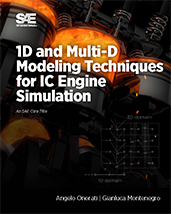Technical Paper
Post-Oxidation Phenomena as a Thermal Management Strategy for Automotive After-Treatment Systems: Assessment by Means of 3D-CFD Virtual Development
2024-04-09
2024-01-2629
The target of the upcoming automotive emission regulations is to promote a fast transition to near-zero emission vehicles. As such, the range of ambient and operating conditions tested in the homologation cycles is broadening. In this context, the proposed work aims to thoroughly investigate the potential of post-oxidation phenomena in reducing the light-off time of a conventional three-way catalyst. The study is carried out on a turbocharged four-cylinder gasoline engine by means of experimental and numerical activities. Post oxidation is achieved through the oxidation of unburned fuel in the exhaust line, exploiting a rich combustion and a secondary air injection dedicated strategy. The CFD methodology consists of two different approaches: the former relies on a full-engine mesh, the latter on a detailed analysis of the chemical reactions occurring in the exhaust line.

